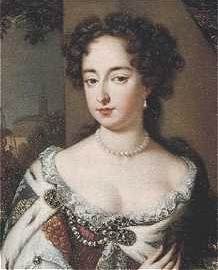

Mary ll 1689-1694
|
Born: St James's Palace, London, 30 April 1662. |
|
Title: Queen of England and Scotland. |
|
Crowned: Westminster Abbey, II April 1689. |
|
Ruling jointly with: William III (II of Scotland), 13 February 1689-28 December 1694. |
|
Married: 4 November 1677, at St James's Palace, William III, prince of Orange: 3 children, all stillborn. |
|
Died: Kensington Palace, London, 28 December 1694, aged 32. |
|
Buried: Westminster Abbey. |
M
ary was the eldest surviving child of James II and an heiress in her own right, though the Exclusion Bills which Parliament sought to introduce during 1679-81, which would have denied her father's accession to the throne, could in turn have denied her. Moreover when James did succeed, his fervent pro-Catholic acts might have closed the succession completely to Protestants, which would have denied Mary's accession again. It was James's Catholicism and his too close an alliance with France that caused Mary's husband, William of Orange, to challenge and ultimately overthrow James. William and Mary became joint sovereigns of England (see under William III for details).Mary remained forever in the shadow of her husband and contributed little to government beyond her good humour. She was the more loved sovereign of the two, and her gay demeanour was much needed at court and in Parliament to lighten William's surliness. Nevertheless Mary had not been raised for government, and did not like it, preferring to defer to William except when he was out of the country. Mary had not welcomed the match with William. She had apparently wept when it was announced. Apart from his ill humour, he was short, almost hump-backed, and with little passion. Mary for her part had no especial liking for men either. The two had three stillborn children in the first two years of their marriage and nothing thereafter. She lived in Holland from 1677 to 1689, where she was much loved by the Dutch. Mary fell out with her sister (and eventual successor) Anne over John Churchill, the Earl of Marlborough. It was Churchill's defection to William in the rebellion of 1688 that had made William's accession so easy, and Churchill had served him valiantly since, but did not feel he had been suitably rewarded. Rumours emerged that Churchill was starting to plot against William. Churchill's wife, Sarah, was a longtime friend of Anne's, having been her maid of honour and lady of the bedchamber. When Churchill was arrested and imprisoned in 1692, Mary expected Anne to dismiss Sarah, but Anne chose not to, and Mary regarded this as an affront. The two were not reconciled within Mary's lifetime.
Mary was only thirty-two when she contracted smallpox and died in December 1694. The country mourned her passing far more than her husband's eight years later. Mary strove to improve the nation's morals, and instructed magistrates to be more active in enforcing the vice laws. She supported the Society for the Promotion of Christian Knowledge, which eventually took shape in 1698, and she had plans to build a hospital at Greenwich, which William carried through after her death.
By kind permission of "The Kings and Queens of England Website" (http://www.frhes.freeserve.co.uk/)